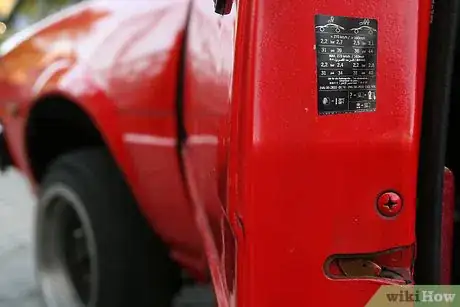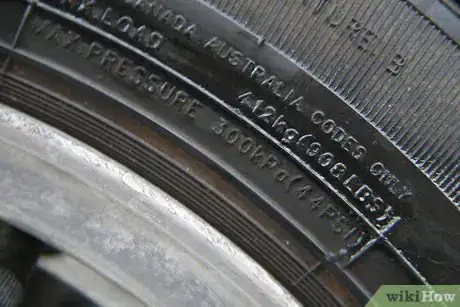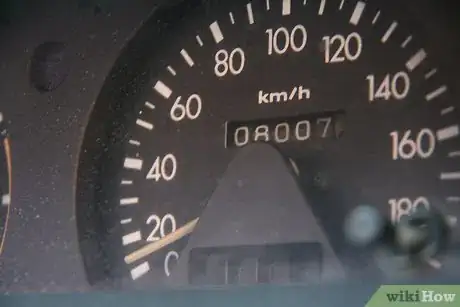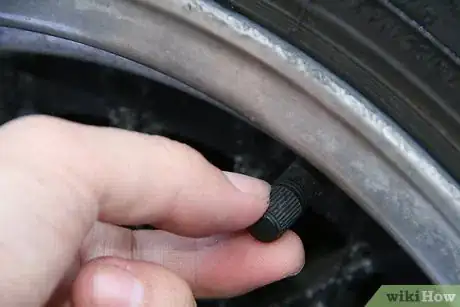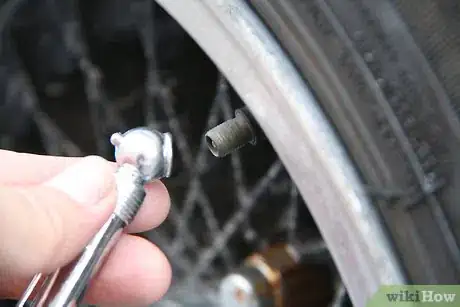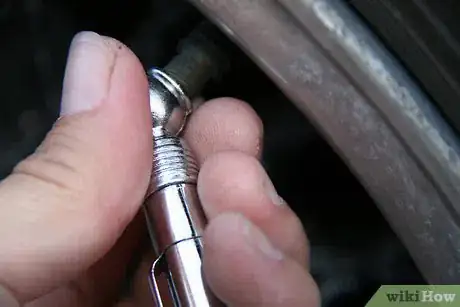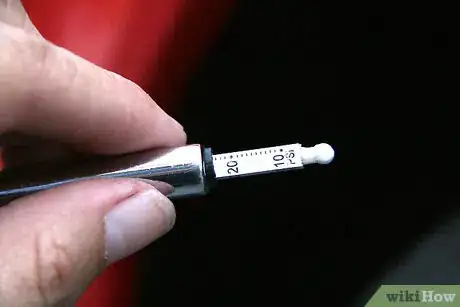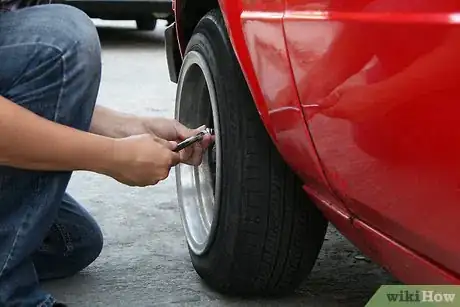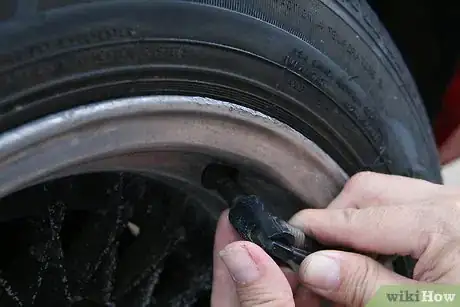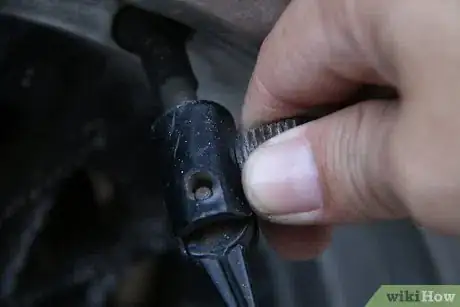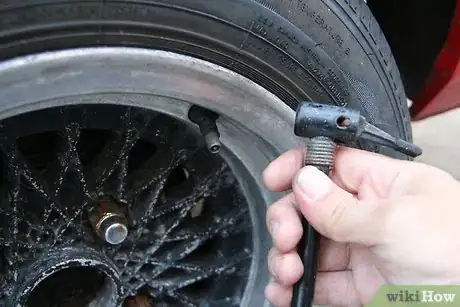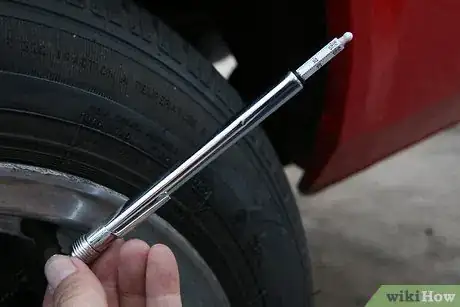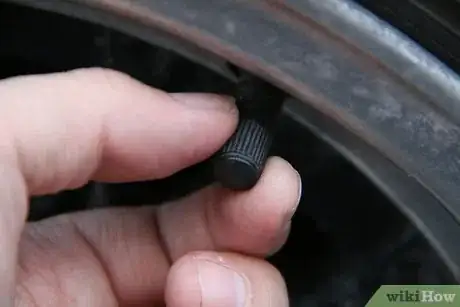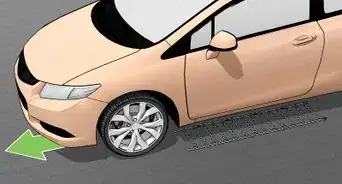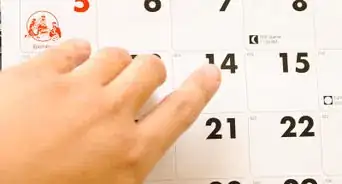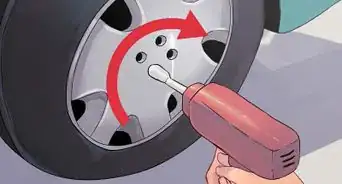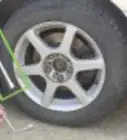X
wikiHow is a “wiki,” similar to Wikipedia, which means that many of our articles are co-written by multiple authors. To create this article, 12 people, some anonymous, worked to edit and improve it over time.
There are 8 references cited in this article, which can be found at the bottom of the page.
This article has been viewed 257,174 times.
Learn more...
Keeping the appropriate air pressure in your tires is one way to help maintain the safety of your vehicle. Low air pressure can lead to overheating the tires, extra wear on your tires, and overuse of gasoline. Learning how to check and add air to car tires is an essential skill that every driver should master.
Steps
-
1Obtain a tire gauge from an auto store or auto department of a hardware store.
- Simple gauges work well. Digital gauges are not necessary.
- Gauge prices range from a couple of dollars to $20.
- Tire gauges measure pounds per square inch (standard) or kilo Pascal's (metric).
-
2Determine how much air should be in your tires. This will be printed on a sticker on the inside of the driver's side door or in the owner's manual. If you can't find the sticker, it may also be located inside the glove box door or fuel door.[1]
- Look at the writing on the side of your tires. The tire will have a maximum PSI or KPA number. This is the maximum pounds per square inch or kilo Pascal's that your tires can handle. It is not advisable to fill your tires to this pressure.
Advertisement -
3Check the air in your tires when the tires are cold. Try checking the tires first thing in the morning after the car has been turned off all night.
- Allow the car to sit for 30 minutes to three hours before checking air in car tires for the most accurate reading.
- If you must drive to check the air in your tires, try to make the trip less than 1 mile (1.6 km).[2]
-
4Unscrew the cap off of the tire's valve stem.
-
5Place the tire gauge onto the tire valve stem.
-
6Press the tire gauge firmly down on top of the valve stem.
- Some air may escape when you begin applying pressure. However, the air should stop leaking out once the pressure is increased and the gauge is evenly on the valve.
-
7Read the gauge to gain information about the PSI or KPA in your tires.[3]
- Standard gauges will blow out a stick. The notch on the stick where it stopped when blown out is the reading.
- Digital gauges will give a digital number as the reading.
-
8Carry out the process with all 4 tires to maintain a balance among them.
-
9Gain access to air either by getting an air hose and compressor ready or putting money into an air machine.[4]
-
10Place the air hose nozzle over the open valve stem.
-
11Add pressure to the nozzle as you did with the tire gauge.
- The nozzle is on correctly when air stops leaking from the outside of the tire and is going inside of the tire.
-
12Allow a small burst of air to go inside of the tire.[5]
-
13Remove the hose when the burst is complete.
-
14Use the tire gauge to see the new pressure of air in the tire.
- Do not go over 5 PSI or KPA than is recommended for your tires.
- If the pressure is still too low, add another small burst of air and recheck the pressure.
- Continue the process until the PSI is met.
- If you put too much air in the tire, press against the pin in the valve stem with the gauge and let a small amount of air release from the tire. Recheck the tire pressure.
-
15Replace the valve stem cap.
Advertisement
Community Q&A
-
QuestionHow do I determine the proper air pressure for my tire?
 Community AnswerThe proper tire pressure will be written on the side of the tire. You can check it with a tire gauge.
Community AnswerThe proper tire pressure will be written on the side of the tire. You can check it with a tire gauge. -
QuestionBest air pressure for Volkswagen fox?
 Community AnswerThat depends on the tire. Check the tire for more info about the amount of bars.
Community AnswerThat depends on the tire. Check the tire for more info about the amount of bars. -
QuestionI have 14/65/165 tires on my car. What should the correct pressure be?
 Community AnswerIf they are the same size as the original tires, there should be a sticker in the driver's side doorjamb which tells you what the vehicle manufacturer recommends as air pressure. Alternatively, the sidewall of the tire has the tire maker's maximum recommended air pressure molded into it - it will say something like "42 PSI" (the number will obviously depend on the car).
Community AnswerIf they are the same size as the original tires, there should be a sticker in the driver's side doorjamb which tells you what the vehicle manufacturer recommends as air pressure. Alternatively, the sidewall of the tire has the tire maker's maximum recommended air pressure molded into it - it will say something like "42 PSI" (the number will obviously depend on the car).
Advertisement
Things You'll Need
- Tire gauge
- Access to air hose and compressor
References
- ↑ https://www.cars.com/articles/how-do-i-find-the-correct-tire-pressure-for-my-car-1420676891878/
- ↑ https://www.bridgestonetire.com/tread-and-trend/drivers-ed/how-to-check-tire-pressure
- ↑ https://www.youtube.com/watch?v=uZkkBvYHSJw
- ↑ https://www.quickanddirtytips.com/house-home/autocar/how-to-add-air-to-your-tires
- ↑ https://www.dummies.com/home-garden/car-repair/wheels-tires/how-to-add-air-to-your-tires/
- ↑ https://blog.firestonecompleteautocare.com/tires/what-if-you-overinflate-car-tires/
- http://www.dmv.org/how-to-guides/check-tire-pressure.php
- http://www.edmunds.com/how-to/how-to-check-tire-pressure-and-inflate-tires.html
About This Article
Advertisement

